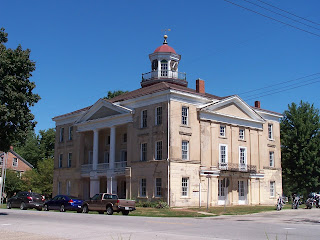Today we visited the Clay and Fiber Fest at Bishop Hill, a small village in Illinois.
Numerous vendors displayed their wares in tents on the lawn
as well as in more permanent displays indoors.
The official Bishop Hill website discribes the history of the colony as follows:"In 1846, a group of Swedish immigrants seeking religious freedom left their native land under the guidance of their charismatic spiritual leader, Erik Jansson. The site for their new utopia, later called Bishop Hill, was described to them as a “land of plenty, brimming with milk and honey,” and they struggled to make it so. These Janssonists built a successful communal society based on economic and religious principles. Many of the structures erected during this building campaign still exist. The colony grew and flourished for fifteen years before disbanding in 1861.
"Today Bishop Hill is a quiet country village where the charm and character of the original colony has survived the test of time. Bishop Hill is a National Landmark Village, listed in the National Register of Historic Places, and it is an Illinois State Historic Site." http://www.bishophill.com/

The Colony Administration Building was build in 1856.
It now houses an art gallery in the basement and guest rooms upstairs.
The Colony Steeple Building erected in 1854
is now the location of a museum.
The Colony Church was built in 1848.
Visitors can still see the worship room as well as numerous
displays about the life of the utopian community.
Of course, the day would not have been complete without a tasty lunch at the bakery
which was built in 1864 as Mrs. Smith's Boarding House.





